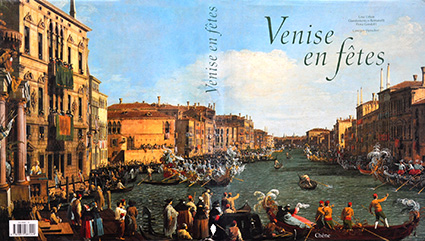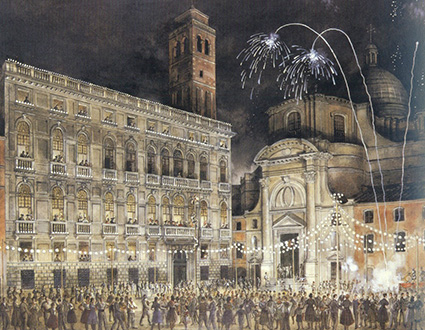

Yesterday as today Venice is always a celebration. Throughout the centuries Venice has never lacked for an occasion or event to turn the city into a theatre of the most brilliant and variegated festivities: official and sumptuous, religious or popular, perpetuated according to tradition or improvised for the glory of the city as well as the pleasure or interest of its inhabitants.
Celebrations in Venice can be found strictly intertwined with its history and, curiously, until now the subject has not been written about extensively. It was necessary to divide it into periods. This work is therefore both a book of history as well as art. The text accompanies rich illustrations, around 300, mostly in colour. Famous painters such as Canaletto, Tiepolo, Carpaccio, Bellini, and Guardi are represented along with works of lesser-known artists.
The texts include descriptions of the "Festa for the Election of the Doge"; the "Festa for the Victory at Lepanto"; the "Festa for the Marriage of the King with the Sea" at which the king would throw a gold ring into the sea; the "Festa of the Bulls" (the bullfights in the piazzas of San Marco and San Polo); the festas and balls during royal visits; the Carnevale of the 18 th century; the "Festa of the Battle of the Fists" on the bridge where the strongest men of every district of Venice would challenge each other for supremacy; the baroque festivals, the Napoleonic festivals, the festivals during the time of Mariano Fortuny, and the famous Bestegui Ball of which all that remains are the beautiful watercolours by Serebriakoff.
Many of the festivals have disappeared as they were tied to a past that has evolved. Others have been recreated with happy results linked with tourism. But, as well, one regularly sees new forms born which give the lie to those critics who would like to characterise Venice as a "dead city", "museum city" or even "the Italian Disneyland".
N.B. The Venetian Carnival was revived in the late nineteen seventies and is very popular with both residents and visitors.
Published by Chêne, Paris, 1992

